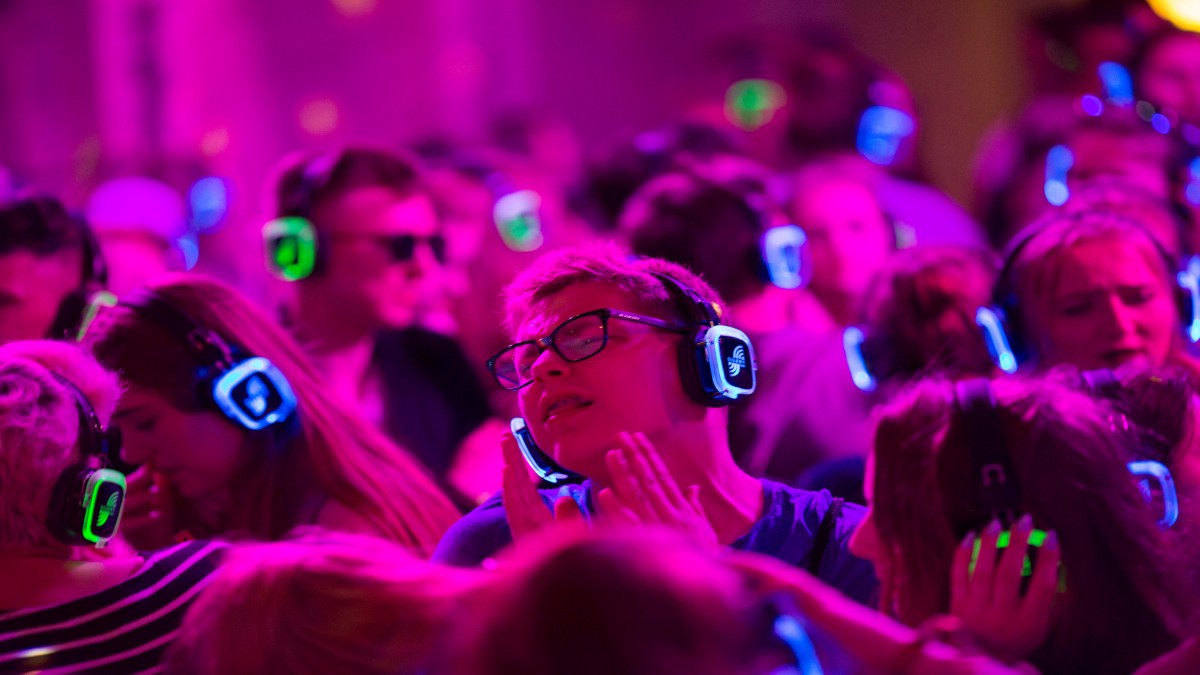Silent discos started back in the 1970s as a convenient way to get around noise restrictions. In those days, that meant everyone bringing their own music loaded onto a Walkman. Later, DJs would set up their own radio channels to allow everyone to listen to the same playlist. These events gained popularity in the early 2000s when music festivals began to host silent gigs with lots of artists streaming on different channels.
At a regular disco or nightclub, everybody experiences dancing together in time to the same music. But at a silent disco, people can be dancing in the same space but out of time with each other, if they’re listening to different music across several channels. This can be a strange experience, but it does provide a very useful context to study the importance of synchrony – more commonly known as being “in sync” on the dance floor.
So what does the “silent disco” phenomenon tell us about dance? Researchers have used it to study social dynamics , finding that it interferes with the social bonding effects of dance. Silent disco may even help us to better understand the evolution of musicality and our rhythmic abilities.
As a cognitive anthropologist, my work looks at why humans spend so much time singing and dancing, and I am particularly interested in how dance “works” as a social activity.
The Silent disco experiment
In a recent study using a silent disco experiment, I wanted to find out how important it was for dancers to be in sync. Since people were dancing with headphones on, we could use this to control whether they were listening to the same music or not. This allowed us to separate the effects of sharing a dance floor from the experience of dancing in sync.
Impact Shorts
More ShortsIn our study, we had pairs of participants listening to the same music, but we manipulated whether the music was in time by adding some delay to one of the channels. Even though they didn’t know that we were manipulating the timing, we found that people preferred it when they heard the music in time with their dance partner. They also looked towards each other more when they were listening in sync.
This silent disco method has also been used in similar studies, in which researchers found that we remember people better if we’ve just been dancing in sync with them, and synchronised dancing may also stimulate the endorphin system which creates positive feelings.
Social bonding
People seem to like each other more when moving in sync . This is true in more naturalistic silent disco studies, but also in very basic experiments that just involve synchronised finger tapping . The synchronisation involved in music and dance may be the “active ingredient” in their social bonding effects.
Singing and dancing with others is a great way of fostering synchrony, but it also exists in many kinds of social interactions. Anyone who experienced Zoom fatigue during the pandemic may have actually been suffering from the slight temporal delay that interrupts the flow of conversation and prevents being in sync, which can get pretty frustrating and ultimately exhausting in a Zoom setting.
While live concerts were being replaced with live-streams during the COVID pandemic, some of my colleagues even observed that live-streams fostered a greater feeling of social connection when compared with pre-recorded concerts, partly because of the synchrony involved. There’s something special about knowing that someone is sharing an experience with us in time, even if we are separated by distance.
Evolution of musicality
Some researchers have suggested that the social bonding effects of music and dance may have been important for the evolution of musicality . They propose that synchronising with others helps to reduce stress by releasing “feel good” endorphins. Reducing stress for other people makes them like you more, which may elevate your social status, or even improve your chance of finding a mate – so people with better musical abilities could be more successful in evolution terms.
An alternative theory suggests that group synchronisation may be a way of displaying the strength of the group to others, such as when a marching band in a military parade. These two apparently competing theories could actually be complementary – although it is very difficult to test this scientifically, because obviously we can’t replicate all of human evolution in the lab, so these debates may never truly be solved.
One thing that is certain, is that music and dance have important social functions in society today. When many people around the world appear to be suffering from loneliness , it is important to understand how people create and maintain social bonds.
It may be that group song and dance was the method of choice for our ancestors, as it still is for many people today around the world. However, if you do plan on making friends on the dance floor, it might be best to ditch the headphones.
Joshua S. Bamford , Postdoctoral researcher, University of Oxford
This article is republished from The Conversation under a Creative Commons license. Read the original article .
)